Live Laugh Love?
While poverty in the world is gradually decreasing, and the 'global south' is catching up with Western living standards, we are busy optimizing our maximum (healthy) lifespan.
Take the tech millionaire Bryan Johnson, who engages in 'intergenerational rejuvenation treatments,' taking 111 pills a day and receiving a blood transfusion from his son. Or look a bit closer to home in the Netherlands. Here, healthcare expenditures per person have sextupled since 1980 — differently phrased as an increase from 10% to 13% of the gross domestic product. But how effective has this big spending actually been for our health?
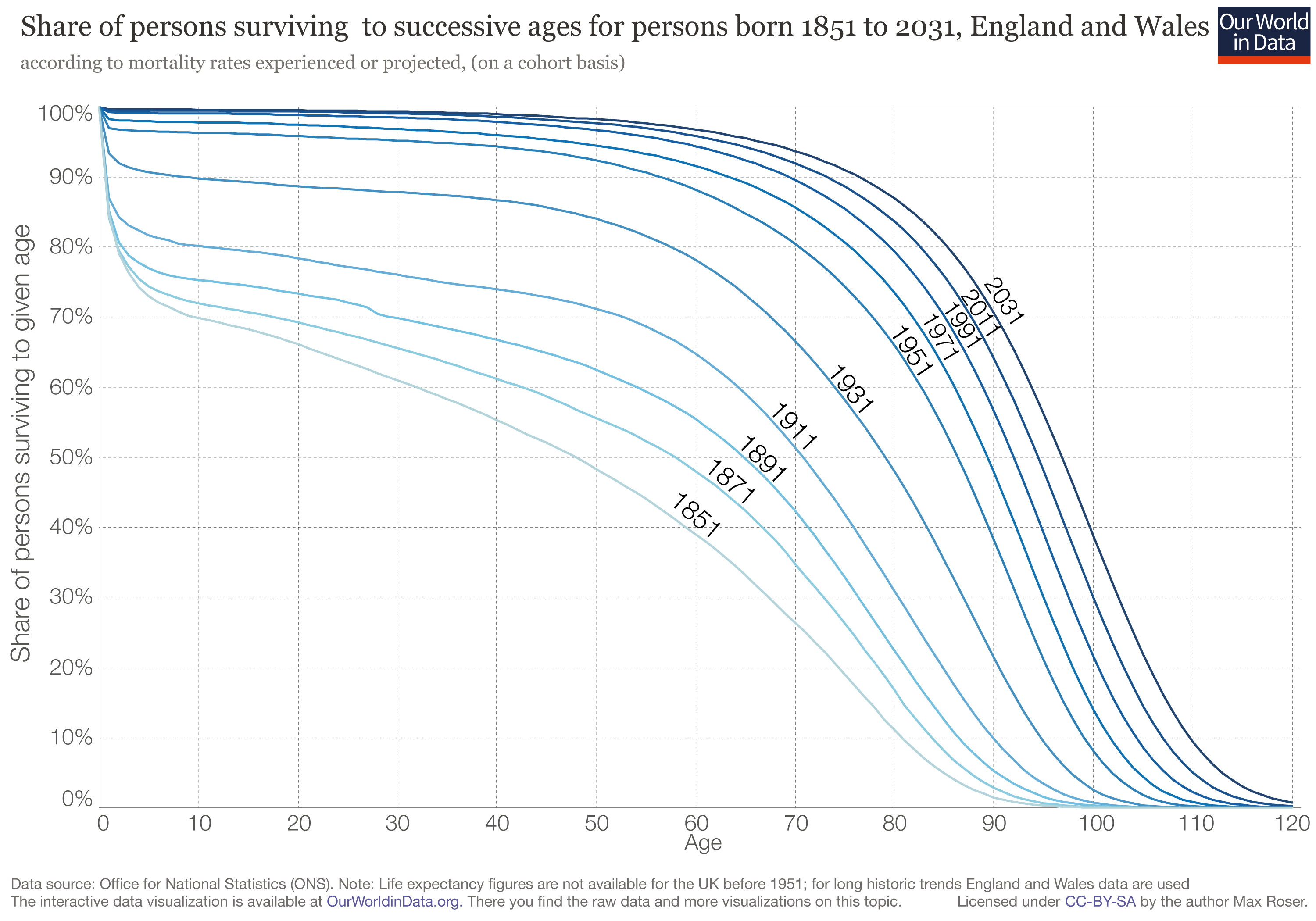
Note that part of this graph are extrapolations into the future (ourworldindata.com).
Survival Curve
Since the 19th century, the average life expectancy has significantly increased. In a so-called 'cohort survival graph,' you can clearly see that with each generation, more and more people are reaching old age (Figure 1-3). Think of it this way: If everyone from a generation were to live exactly to a 100 years, the line representing that generation's survival rate over time would move straight up to 100 years and then drop sharply. In reality, this happens in a somewhat more natural manner, and the 'apex', or the corner of the line, moves more in a flattened curve. Over the past 200 years, this apex has gradually shifted towards the corner, meaning that the group of people reaching 60 is getting larger.
But something strange is happening. Because when the imaginary generation with the rectangular curve from before doesn't reach 100 but 110, then the line would only drop around that age. This is what we call lifespan. In the real curves, this lifespan has shifted somewhat to the right, but it seems to reach a certain limit. So, you can see that, on average, we have become older, but as humanity, we haven't aged equally rapidly.
Considering the improvement in healthcare, one might expect that lifespan would at least rise consistently. This raises the question of whether we can infinitely keep shifting the line to the right. Additionally, we should consider whether we actually want to live longer. This also involves how long you can lead a healthy life: in the Netherlands, an average of 70 out of the expected 81 years. Generally, people in the Netherlands would, since 86 years old is considered a ‘good age,' and three-quarters of those surveyed in this study would like to live to be 100.
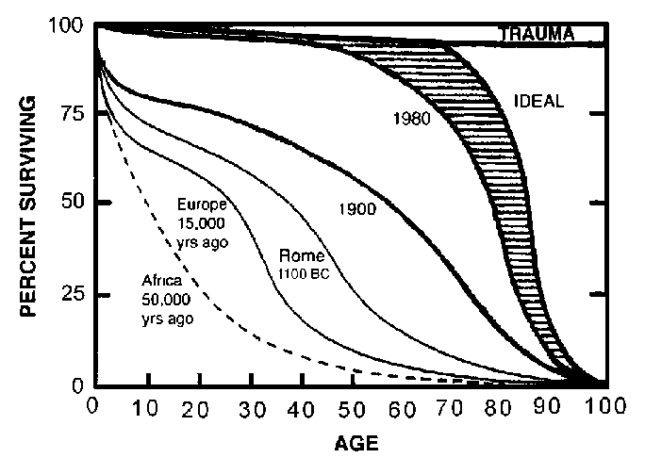
A limit to life
But we shouldn't get ahead of ourselves because, in practice, extending lifespan appears to be more challenging than reducing premature death.To understand why, we need to explore the biomedical causes of aging. The Max Planck Institute maintains a comprehensive list of causes they believe are relevant to old age.
At a young age, the body is still highly efficient at repairing errors in our DNA and eliminating poorly functioning cells. But why does this process become less effective as we age? The underlying processes of aging have been increasingly well-researched and provide good reasons for how we age.
Repairs aren't always perfect, and small harmless errors accumulate slowly until something goes wrong, like the formation of a cancer cell. Another well-known example is the gradual breakdown of protective caps at the ends of our DNA called telomeres. While these can be repaired, it mainly happens in reproductive cells like egg and sperm cells, where DNA must remain perfect.
The proteins responsible for carrying out various tasks encoded in DNA are usually monitored and cleared. However, this process increasingly fails, leading to the gradual accumulation of poorly functioning proteins in our bodies. This causes various forms of dementia, such as Alzheimer's and Huntington's diseases.
Furthermore, other processes that gradually become less efficient are discovered. Malfunctioning cells cause disturbances in nearby healthy cells and release substances that signal this to the rest of the body, resulting in chronic inflammation that disrupts communication between various cell types. Additionally, the signaling and uptake of nutrients from food are disrupted, and the balance of good and bad bacteria in our gut flora becomes imbalanced.
It's still possible
All of this may sound somewhat ominous. After all, we are biological machines designed for reproduction, and at the core of this evolutionary process lies the genetic variation facilitating all of these defects (Vijg & Bourg, 2017). Thus, it seems inevitable that after eliminating the low-hanging fruit over the past 150 years, we are getting closer to a biological limit.
However, we have not yet found any clear reason for this to be true. There is a chance that treatments or, even better, prevention methods for all these different aging processes will be developed soon. According to Blagosklonny (2021), the level of care received by extremely old people is the reason for the leveling of mortality, and they could potentially live much longer. There is also statistical uncertainty about predicting the decline or rise in mortality after a certain age because there simply aren't as many people living that long (C.G. Camarda, 2022).
The extent to which future measures are conceived and implemented depends on the collaboration between an effective society and the pace of technological progress. This is also one of the reasons why there is still no scientific consensus on whether our species can continue to age. Data and graphs like those at the beginning of this article are based on cohorts from different generations in history and are thus a reflection of the society of their time.
The question of whether it is possible to live longer is, therefore, more about whether it seems likely to happen.
Blagosklonny MV. No limit to maximal lifespan in humans: how to beat a 122-year-old record. Oncoscience. 2021 Dec 1;8:110-119. doi: 10.18632/oncoscience.547. PMID: 34869788; PMCID: PMC8636159.
Cutler RG. Evolutionary perspective of human longevity. In: Hazzard WR, Andres R, Bierman EL, Blass JP, editors. Principles of geriatric medicine and gerontology. New York: McGraw-Hill, 1990. pp. 15 – 21.
Dang, L. H., Camarda, C. G., Meslé, F., Ouellette, N., Robine, J.-M.; Vallin, J. (2023). The question of the human mortality plateau: Contrasting insights by longevity pioneers. Demographic Research, 48, 321–338. https://doi.org/10.4054/demres...
Gavrilova NS, Gavrilov LA. Are We Approaching a Biological Limit to Human Longevity? J Gerontol A Biol Sci Med Sci. 2020 May 22;75(6):1061-1067. doi: 10.1093/gerona/glz164. PMID: 31276575; PMCID: PMC7243589.
Jan Vijg, Eric Le Bourg; Aging and the Inevitable Limit to Human Life Span. Gerontology 17 August 2017; 63 (5): 432–434. https://doi.org/10.1159/000477...
Harry van Dalen & Kène Henkens (2017), Hoe oud willen we worden? Demos: bulletin over bevolking en samenleving 33 (8): 8.
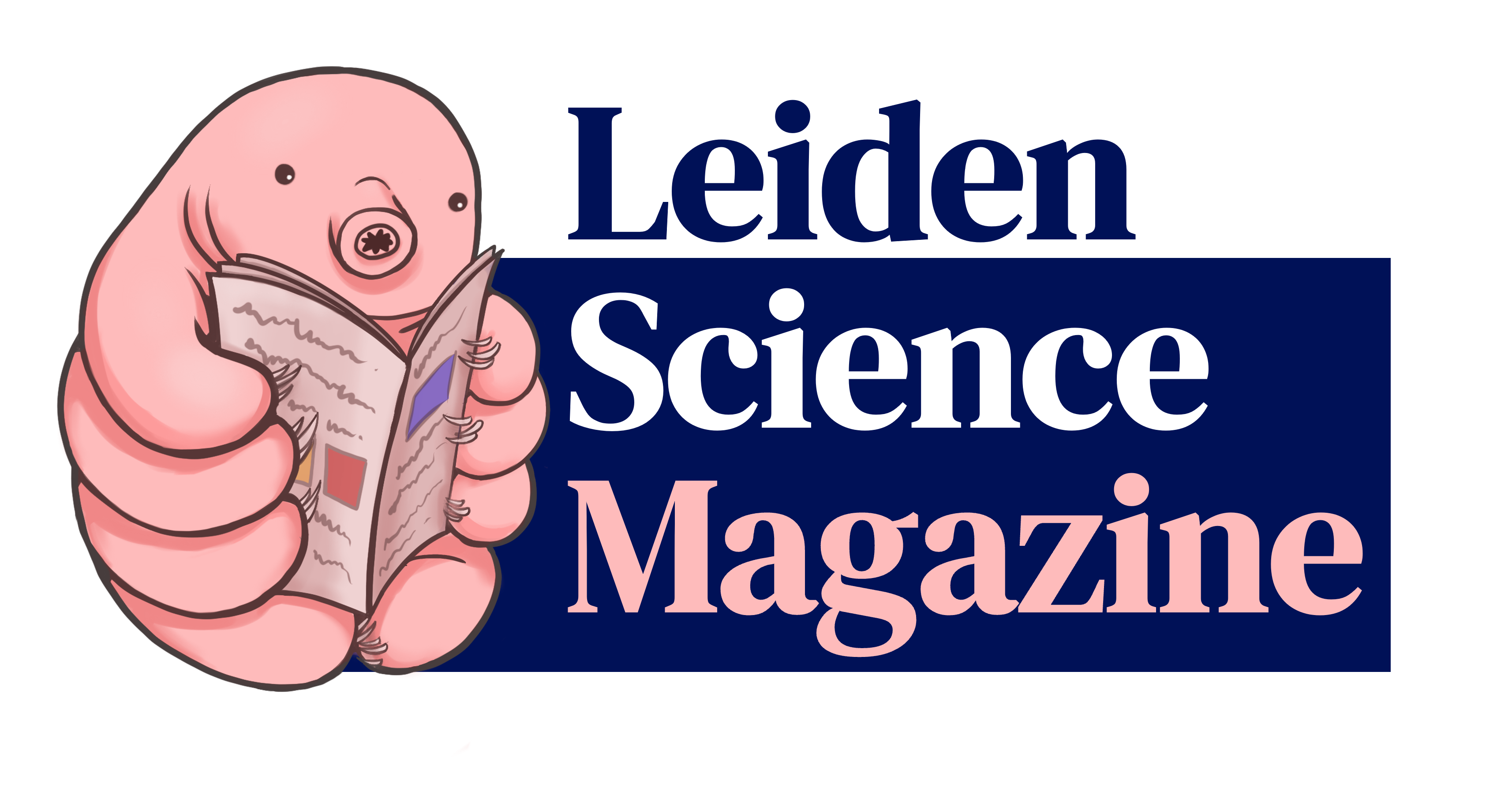

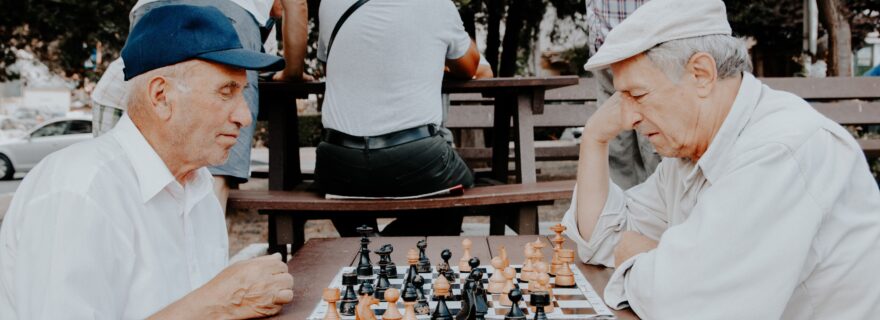
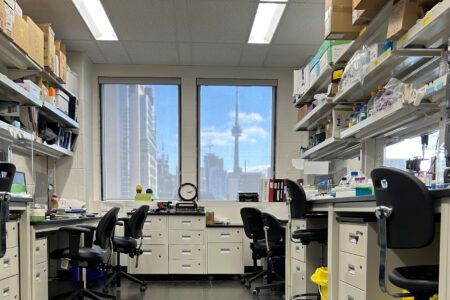


0 Comments
Add a comment